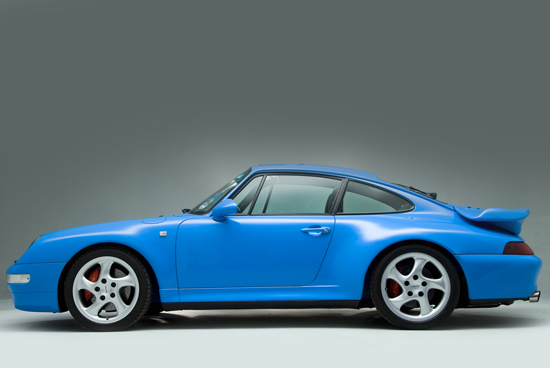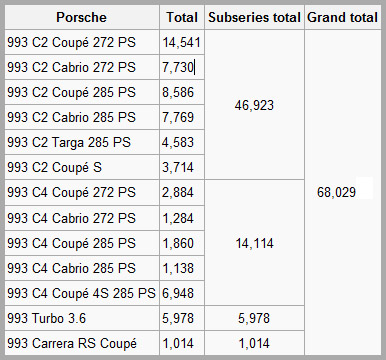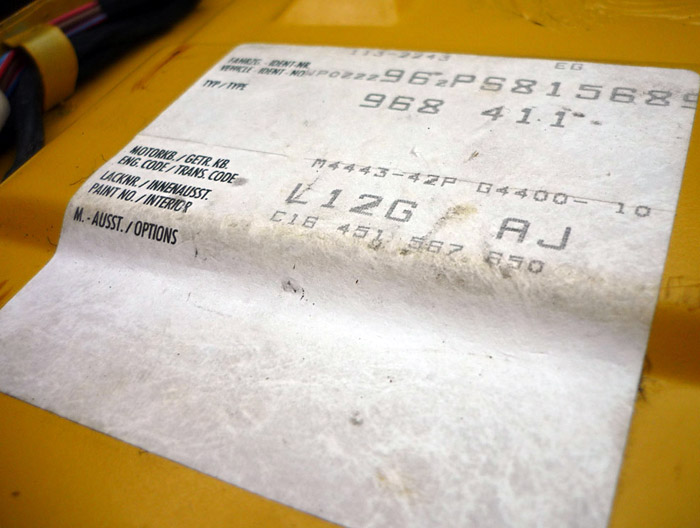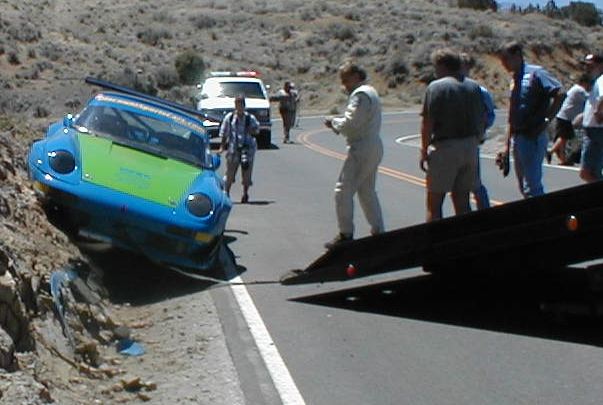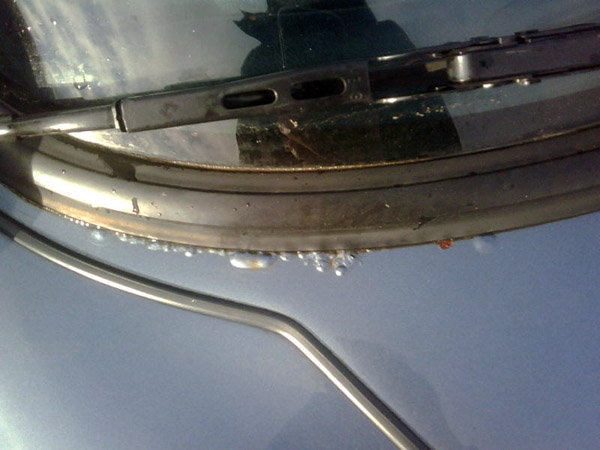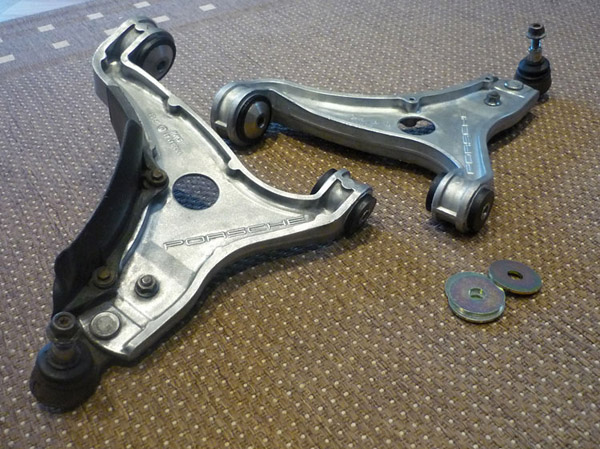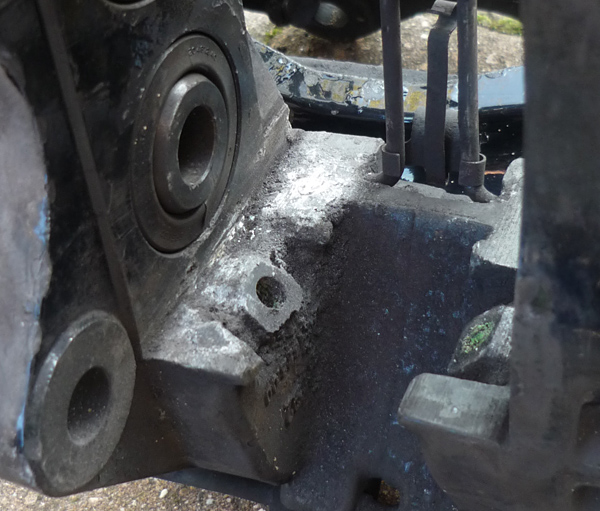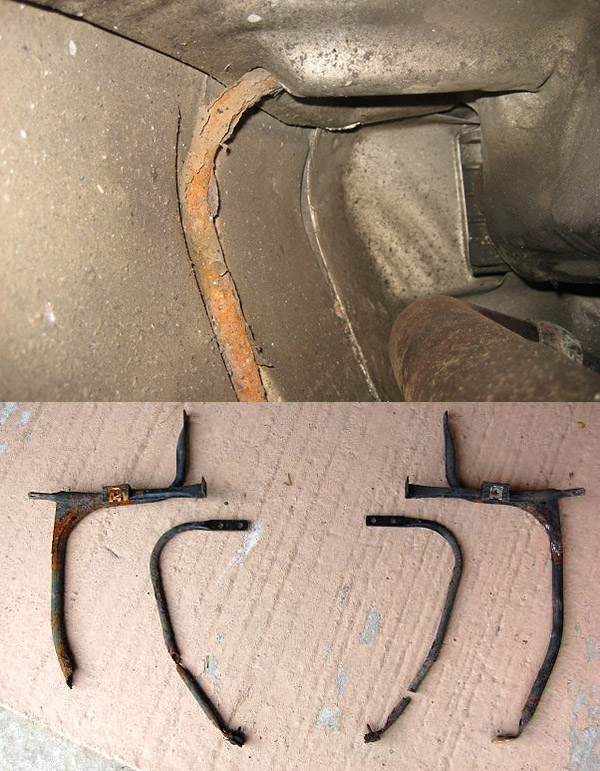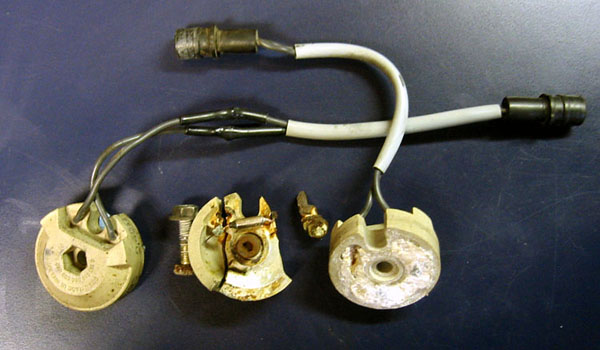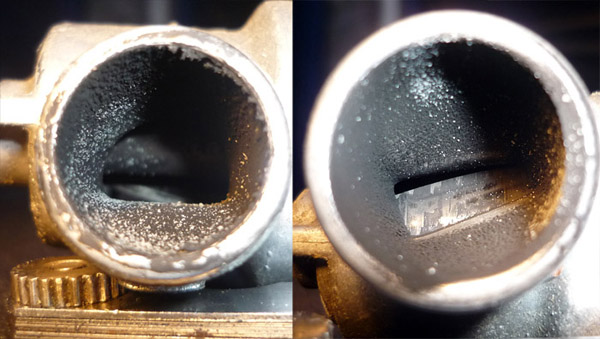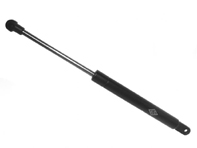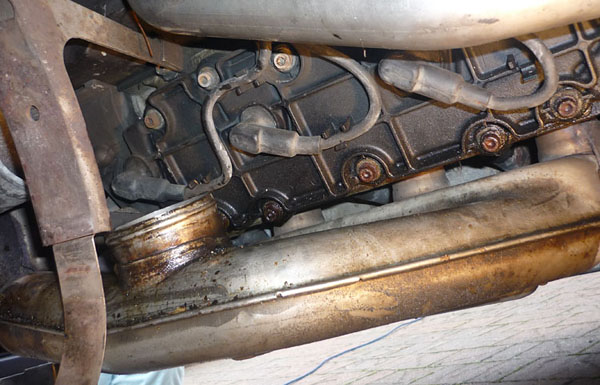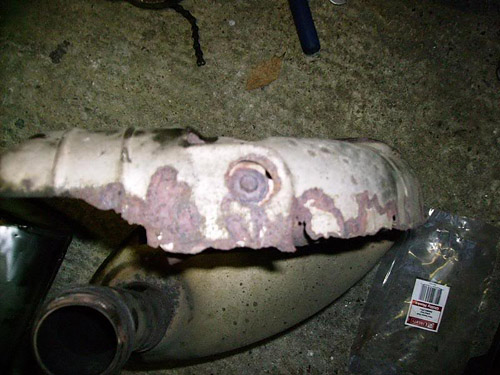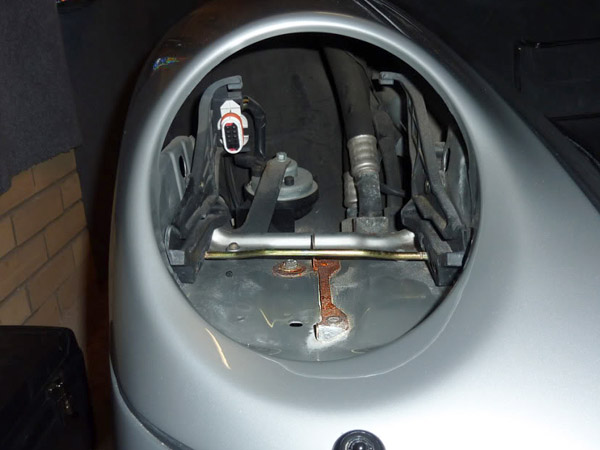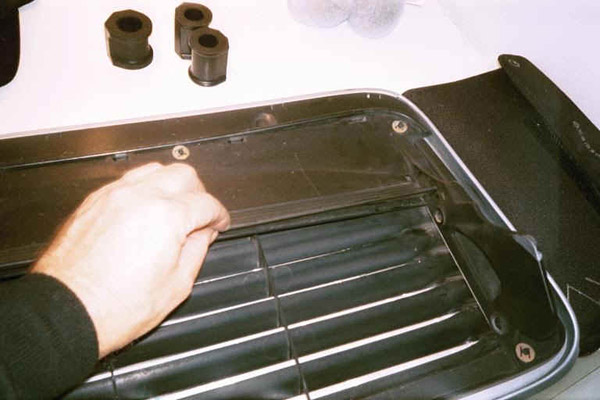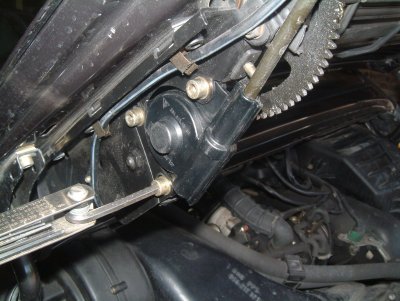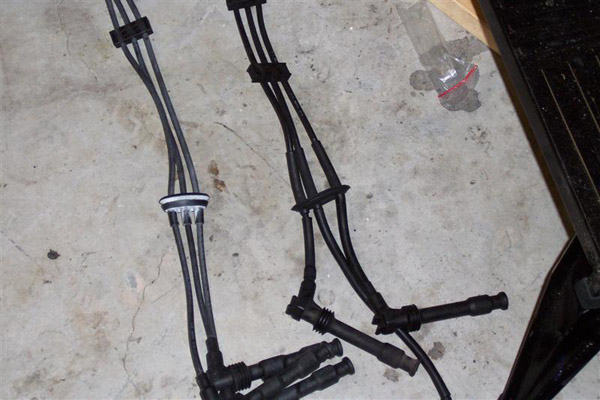993 Buying Guide
If you are considering a 993 then there are a number of big decisions you will initially need to make as the model range is quite complicated.
NA, TURBO or RS/GT2 This is an easy one and you'll probably know already. The twin turbo 993 (and turbo S model) is obviously turbocharged and is 4wd. It has over 400bhp and there is little between it and its newer sibling the 996 turbo in terms of outright acceleration. It is a LOT faster in a straight line than an NA or normally aspirated 993 but then it is also heavier and a less nimble car. What it might lack in terms of feedback and mid corner involvement though, it will make up for in terms of its grunt, A to B squirtability and incredibly gorgeous looks. Like all the 911 turbos it is slightly more GT orientated as a car, has more foolproof handling and a big and instant power delivery that does not need to be wrung out with vast amounts of revs.
The RS and the even rarer GT2 are very special models and if you are in the market for one of those then you're probably connected to a knowledge base that exceeds the boundaries of this article. Either that or you're paying the sort of money and benefiting (one would hope) from the sort of dealer experience where absolutely every eventuality will be covered and the car will have been pre-inspected with a fine mircroscope inch by inch. If not, then read on because just about every weak point of the 993 is applicable to the RS as well. For most people though, you will be consdering a normally aspirated 3.6 litre car so our article will continue on that basis.
One word on the turbo before we leave it behind. Whilst many of the weaknesses that I'll list here will apply to the blown car as well, the 993tt has a different engine, 2 turbochargers and a different level of stress running through its drivetrain. Turbos can need rebuilding in later mileage cars and the bills can very quickly become quite big so make sure you do your additional homework. Bottom line is the Turbo is significantly more expensive to run and will at some point come with supercar type bills.
NARROW BODY OR WIDEBODY If you are going for a regular NA 993 then this is the next major decision. The widebody cars or 'S' cars are 3 inches wider at the back and wear 18" alloys so have the turbo looks (without the spoiler) for less money and less running costs. Many find that they are the best looking 993 there is and the used prices have always seemed to reflect this. They comand a hefty premium in today's market and the very best example wide body cars can be priced more than the higher mileage Turbos. There are essentially x2 S models, the 2 and 4 wheel drive: C4S: 1996 - 98 model year. Widebody 4 wheel drive Carerra, running lots of extras: lowered suspension (codenamed M033), solid spoke 18" Cup 3 alloys, bigger 993 Turbo brakes (often named big reds), full leather interior, hifi pack, on board computer & sports seats. Mechanically the widebody cars are the same as the narrow bodies. Apart from the slightly bigger costs for the C4S's larger discs and pads, they will be the same to maintain. Whilst many people covet the sexy looks of the WB cars, in the eyes of others the slim narrow body cars better represent the original untainted 911 shape. Many people report that the drive of the narrow body is slightly more nimble and it is arguably the top choice for a part trackday car (Porsrche themselves based the RS on a narrow body). Ultimately though, you'll probably know if you want an S or not and unless you're into Cat D or interstellar milage cars, you'll be shopping in totally different price brackets. At the time of writing (winter 2010) NB cars range from about £15,000-£26000 with a few bonkers low miles and/or upgraded examples up around the 30 mark whereas the widebodies really start at £27000 and can be over £40,000 for the very best examples at the country's priciest traders.
C2 OR C4 This again will be quite personal. The purists will want 2 wheel drive and nothing else will do. Others will prefer to bask in the security of the 4wd system (which I hasten to add is operating around 95% rear wheel drive for most of the time). I have driven both (in 964 model range as well) and I found that the C4 definitely felt more tied down and stable whereas the C2 has more of the classic front end bobbing feel where the nose can patter around a bit and feel like its gently moving laterally this way and that. A tiny but more steering chatter and agility in the C2 as well but you are splitting hairs here really and bear in mind that after 15 years all cars will drive radically differently in any case. Some will view the front end bob, the slight feeling of instability, the loose tail on the throttle as inherent and requisite 911 idiosyncracies. Others couldn't care a less and would rather benefit from the extra security and all weather point to point ability that the all wheel drive system affords. In terms of standard geometry settings, the C4 has less of a tendency to understeer out of bends and in the wet you can get on the gas and fire off to the next bend whilst the C2 driver is still gathering himself and waiting to apply full throttle. The back is more stable and less playable than the regular C2 but on a dry circuit it's the C2 which will probably be faster. The C4 is slightly heavier but not by much.
MANUAL OR TIPTRONIC If you aren't sure if you are a tiptronic type of guy then chances are you might be. Manual people will know who they are and I recently read an amusing quote by one such individual who said he'd rather drive a manual Golf GTi than a Tiptronic 993. Tiptronic is opbviously great around town and the box compares favourably with autos of similar vintage so don't rule it out if you are unsure. The tip cars do suffer ever so slightly in acceleraion and top speed but then that probbaly won't matter much if you are considering one.
COUPE, CABRIOLET OR TARGA The cabriolet is a much loved model. They start out as a coupe and are chopped to shape then strengthened down below but they obviously won't be quite as rigid as a pure fixed head. There are no real reasons not to go for one though if open top motoring is your thing. The targa roof is expensive to fix and it is heavy but if they appeal then again, there is no big reason why you should avoid them. Porsche specified that the Targa should only wear 17" rims to limit vibration to the glass.. just a quick one that just in case you were planning on buying a Targa and fititng it with bling 19" chrome Kahn alloys.
VARIORAM OR PRE-VARIORAM The varioram system was added in 1996 and first of all to the carrera RS. It involves an intake manifold which actively changes the length of its intake system through the rev range meaning an increase in peak power up to 285ps from 272ps and greater midrange torque. The later Varioram cars are most definitely more sought after and they will command a higher premium. They also have revised gear ratios with a longer 3rd and 4th and definitely have more midrange uuumph. They also make a more throaty noise higher up in the revs which many find more pleasing. Try and test drive both and see how important it is to you but the general advice amongst the enthusiasts is that in a increasingly threadbare secondhand market don't let varioram or lack of it, stop you from buying a good pre-varioram example. Unless you are an absolute purist the same could be said about the C2/C4 decision. Find the very best car you can for your budget; a 2 or a 4, varioram or the earlier 272ps car will all give you the true 993 experience.
MILEAGE Not much to say on this. If you can afford and indeed find a 30 or 40k example and not be worried about using it then go for it. One common view for the value concious is that 85,000 miles is the sour spot if you like. In another 10k miles or so the car will drop a fair bit in price so the more sensible route is to either go for a 60k-ish example or skip ahead and start with a car that's already broken 100k miles and save yourself a ton of cash in the process. Having said that, finding 60k examples is becoming increasingly difficult. A few years ago there were plenty around but the low miles cars really have now completely dropped off the radar, especially manual C2's. I wouldn't personally be put off by high miles. As always buy on condition. The engines are very tough if looked after and serviced properly and the need for a top end rebuild is not nearly as common as it is on 964's. It goes without saying though that on a high mileage car you would want to see plenty of evidence that stuff has been renewed and replaced, sometimes several times over during the cars life. For an idea of what items I am talking about see my list of common problems and you will soon see the items which wear and have a limited lifespan. You would also perhaps pay significant attention to the gearbox and its oil changes, the engine health and all of the suspension from bushes & ball joints to coilovers and top mounts.
VIEWING AND INSPECTING
It goes without saying that all the normal used car buying rules apply. If it's a private sale then asess the owner as much as you do the car, not only the way he drives his own car from cold but the way he keeps his service history, how picky he is about his car, the state of his house, and his overall demeanour and stance toward you as a buyer. I like to take a good look at how someone drives a car. It's quite surprising how nervous and erratic people are even in their own vehicles that they've owned for years. How much mechanical sympathy does the person show and ultimately, would you trust them driving one of your motors for very long ? Check all the usual things like tyres, brake pad thickness, panel fit and finish, under the carpets, front bumper condition, all the electrics, seat and pedal wear etc.. When you test drive the car do the same, paying careful attention to the idle, power delivery and it's smoothness, what comes out of the exhaust, clutch operation and any slip, effectiveness of the brakes, the damping and how the car absorbs low speed and high speed bumps, how directionally stable the car feels, how much it is perturbed by bumps and road imperfections, straight line stabiliy at high speed, general balance and 'rightness' of the car in a bend etc..
This is by no means exhaustive and some of these might not amount to much money to fix but here's a list of checks you can perform which are specific to the 993. Without getting the car on a ramp and dismantling things you are pretty limited but there are certain key things that you can do.
1. Find the white square information label on the underside of the bonnet near the catch. Read off the vin code and the paint and options codes and ensure that they not only tally with the car but they also tally with the vin plate that is on the bottom of the windscreen passenger side (facing outward) or in earlier models this will be a plaque in the luggage compartment on the inside of the RHS wing. There should also be an additional paint label inside the front boot (see my second pic). There is also a chassis number on the tamper proof sticker in the drivers door shut on later cars. Cross reference the vin to the V5 or log book as well. You can find decode the options and the vin here and here (courtesy of p-car). In short, make sure the car you are buying is the car that was described by the factory ! If there are any discrepancies then investigate some more.
2. Open the front bonnet, lift the carpet and check the spare wheel and toolkit are there. Check for corrosion and the integrity of the body ensuring there's been no repairs from crash damage and repainting. Check for rust around the battery. 3. Pull back the black rubber seals/surrounds around the front and rear windscreens (particularly on the lower corners). You need to have a good look inside for rust here (a pocket torch can help). Water collects in here and grit can get in between the rubbers and then as the bodysheel inevitably twists and flexes during use, it starts to abrade the paintwork particularly on the surface of the scuttle. Look for bubbling all round the edge and just inside these seals both front and rear. You can also listen out for the sound of the windscreen creaking during the test drive. If you do see corrosion then eventually you will need to take the entire glass out and treat and repaint which could be as much as £1500. This is one of the major 993 checks, it's one of the weakest points of the car design-wise. If both screens have been got at then its going to be a big job and unless the price is very attractive, consider skipping onto the next car. 4. Open and close the doors to check that they are smooth. Clicking sounds may mean that the door check straps are on their way out which is another well known weak point. They will eventually cost a fair amount to put right if they pull their mounts away from the door pillars, somewhere in the order of £1000 5. Push the rear bumper around and make sure it is solid. Excessive movement here will probably mean that the rear PU supports have rusted through (again a known design issue). This should cost around £200 in parts and is a 2-3 hour job if the bumper fasteners come off easily. 6. Look for oil drips underneath the car. Also when the car is idling make sure you don't smell burnt oil and see smoke coming from either wheelarch. The 3.6 can leak from various areas like the chain covers and the valve covers. The lower valve covers seem to fail on a fairly regular basis. They are situated low down inside the rear arches and behind the squashed cylinder shaped exhaust silencers. They can warp and oil can also leak through the aluminium bobbins. When they do it will drip down onto the hot heat exchangersbelow (the kidney shaped pieces of metal) where it will burn and create smoke. A new valve cover plus screws and gaskets is around £90 per side. To fit it should be under 1 hours labour. Oil leaks from other areas like the gearbox shaft seal, the chain covers are going to be difficult to spot especially as leaking oil is usually caught unoticed by the engine and gearbox undertray. It's still worth having a look if you can though especially if the car is in its customary storage place. 7. Open the front and rear lids and make sure the dampers hold the weight of the lid properly. This is very cheap to fix and the sort of thing that isn't going to bother you if you discover it a few days after purchasing but again it's a common problem and if you're buying from a dealer something to get them to sort out as part of the prep. 8. Inside the car operate the spoiler manually with the switch on the lower console. Ensure that you don't hear a grinding noise. If you do then the spoiler bearing is on its way out. Again, only an hour or so to fix but worth noting down on the list. 9. Start the engine. It should idle nicely at 800rpm. Poor unsettled idle could mean a dirty ISV valve which is a very easy DIY. 10. Check the exhaust for smoke. Excessive smoke could mean worn valve guides which means you're into a top end rebuild and at least £3000 of money. Excessive oil usage could also support this too. Porsche specifiy excessive as more than one quart per 600 miles. This is not considered a common issue with the 993 though and engines go on for many many miles without needing rebuilds. Blue smoke could also be from an overfill of oil so best to check the dipstick first as well before walking away from a car. 11. Check all the electrics and in particular the sunroof operation, the AC and the electric seat controls. The front seat electrical wires can become sheared and the switched can need a cleanup form time to time as well. Simple fixes but worth noting. 12. Check the oil cooler operation. The oil temp gauge should first rise to the 8 or 9 o clock position then drop back to 7 o clock before rising again. This is the front oil cooler coming into operation. After that the needle will rise again and should stay below the 9-10 o'clock position. If it goes over then you the car may have a broken ballast resistor (see below). 13. When driving oil pressure should be nice and high up at around 5bar. When idling it should be between 1-2.5 bar. 14. You can generally ignore the oil level gauge. It often gives wrong readings and of course is not meant to be read at all when the car is being driven. Owners go by the dipstick. 15. Clutch issues will immediately be obvious. Budget £1000 to supply and fit if its on the way out. A notchy and grinding gearbox could mean a rebuild which will be even more costly but a bit of recalcitrance (especially into 2nd and out of 1st when cold) could just mean the car needs a change of gear oil and maybe some new engine mounts. 16. When driving, aside the normal checks pay particular attention to an excessive wandering nose, harsh bump damping and overall stability and 'rightness' of feel. Does the car feel together and tight ? Worn suspension is very common and the standard coilovers do not last very long, typically only 40k miles or even less so if it hasn't been changed at least once in it's life then be on your guard. New springs and dampers starts from around £500 and goes up to £1500-£2000 for the road and track orientated adjustable solutions. But do bear in mind that any under par ride and handling issues could be down to wear in the top mounts, ball joints or any number of bushes. Fitting new suspension is around 4-6 hours labour and then geometry another £150-£300. If you have to change other bushes or arms or loosen off stuck bolts (quite common) then that will add more to the labour time. 17. Although it's very difficult to diagnose suspension issues just from a test dirve (simply because there are so many parameters that can go wrong and affect things), vague steering that pulls forcefully left and right (esp. under hard braking) could be a sign of worn front wishbone bushes (see below for costs). Shot dampers will feel harsh especially over low speed sharp bumps. Knocking noises from the rear could mean that the car needs new link arms at the rear. 18. Check the car jacking point underneath the car. Check the car hasn't been jacked up carelessly and check that any oil or AC lines (that run along the lines of the sill) have not been crimped or damaged in any way. 19. If you can get on the floor of the car lifted up, then try and take a look at the rubber boots that go over the ends of the steering rack. If these are split then dirt quickly gets in and this obviously isn't very good for the rack. Try and check the rubber driveshaft boots as well. These should not be split and if they are then it's possible you could need new CV joints. Also check for any leaks around the dampers and the condition of any ball joint boots, drop link boots and the anti roll bar bushes.
COMMON PROBLEMS
You obviously won't be able to check all of these before buying but here is a list of the common 993 problems and approximate costs to rectify. Although the list looks long many cars you see will have had some of the work already done and in the main the 993 is an extremely well built and reliable car, arguably the most reliable of all the 911's yet. Some cars will never see any of these problems and many of them will not surface during your ownership so don't get too worried. They are just some of the things you might have to deal with during your time with the car.
poor geometry
poor geometry The 993 (well all 911's) are very sensitive to correct geometry. The correct angles can make the difference between a lethal widowmaker and a planted and secure car that drives straight and is composed and resolved over bumps too. Independents such as Promax and Tognola will charge around £150 to adjust the front and rear toe, castor and camber. Chris Franklin at centre of Gravity will come out at the £300 mark but he is recognised as one of the best in the UK. He will also corner weight and check over all the suspension, release any stuck bolts and baseline the whole car before any adjustements are made. It's important before you do any geometry to have the car fully checked over so that you know that no bushes, ball joints, wishbones or links/arms need replacing as there is no point in paying to have your geometry twice.
This is a very common issue and a pretty weak part of the 993's design. The screen is bonded in and it flexes around a fair bit. Water gets underneath the seals and then grit gets in there too and can start to abrade the paint, particularly the scuttle on the lower corners. This happens on the rear glass as well. A repair is costly and means the glass has to come out and the whole frame has to be treated and prepped then painted. Somtimes owners get this done 'conveniently' as part of an insurance windscreen replace as well which can help costs a little. Ultimately though, if a car you see has issues front and rear then I'd start thinking in terms of big discounts from the price.
The bushes in the front wishbones or A arms have a limited lifespan, maybe 30-40k miles or so. After a while they start to separate from the arm and bulge outwards. You can move the wishbone with a pry bar and see how much it moves; it shouldn't be too loose and the bushes should not be bulging out or cracked and they should not be coming away from the cylindrical space in which they sit. Shot bushes here will mean vague sloppy steering and lots of unpleasant side to side movement from the front of the car particularly under hard braking. Traditionally the fix id to buy brand new arms from Porsche as the bushes are pre-bonded in (arms are around £260 each). But nowadays you can buy new aftermarket bushes, either polyurethane or rubber of the same spec hardness, and have them pressed in. A set of bushes will typically be around £80-£110 and an indy will charge around 1-2 hour to fit them in but then another 1-2 hours labour to remove & refit both wishbones. You will need a quick geometry check as well afterwards.
The two impotent spot welds on the mount for the door check straps can eaily fail inside the A pillar. Listen for a clicking sound when you open both doors. If not treated, the mount can then detatch completely and a proper repair is around £500 per side.
Weak braking performance or rust on the insides of the discs could mean corrosion underneath the caliper spring plates. This problem affects all aluminium based brembos before the 996 models. Water ingress between the spring plates (that the pads sit on) and the caliper body leads to bimetallic corrosion (especially with salt on the road). The caliper plates get pushed up squeezing the pad and heavily reducing braking ability. If left untreated the caliper can get progressively eaten away. Repair is around £60-£80 per corner. An alternative is to refurbish the whole caliper including brand new paintwork, new seals, pistons, plates and nipples. This will cost around £150- £180 per caliper (not including the cost of removing and refitting).
The rear bumper supports are prone to corrosion. Signs for th this are a bumper that is not firmly fixed and looks out of sorts or moves around far too much when you push it.
The standard suspension only lasts around 30k miles so if it hasn't been renewed of late, or upgraded for something better then budget for this. A poor handling 993 will completely ruin your ownership experience. Fitting more modern suspension like Bilstein HD or KW variant 3 is just about the best thing you can do to a 993 to transform it and bring it into the modern world. Standard suspension will be around £500. The popular bilstein Hd setup around £1000 and the track and road orientated KW and PSS10 setups aroudn £1600-£2000. After that you are into Moton and JRZ which will be even more money but is more for out and out circuit cars. You need to pay to have it fitted and for full geometry as well. Of course worn suspension is not confined to dampers and springs. Have all the rest of your suspension fully checked over at the same time including all ball joints and bushes on all 8 arms at the rear, anti roll bar bushes, inner and outer front tie rod ball joints, front steering arm ball joints, front wishbone bushes and front and rear suspension top mounts which can also crack and perish over time. Anything that isn't as it should be will adversely affect the way your 993 drives.
Wayward unstable handling or a crunchy gearbox could signify that the engine mounts are on their last legs. Many people upgrade to the Carrera 4 mounts which are a bit stiffer. Budget around £200-£300 for parts and an hours labour. The RS engine mounts are another option for an even more connected feel but a reinforced or RS engine carrier is recommended if you fit these (itself another £300).
The inner tie rod ball joints that attach to the rack are notorious for wearing prematurely. You need someone to rock the wheel whilst you feel for play at the ball joint so not something you are likely to be able to do on a test drive. A small check on the front toe will be required after fitting.
Dead ballast resistors either on the oil cooler or the A/C condensor The oil cooler and A/C ballast resistors fail with age. They are hidden will inside the front arches and difficult to get to. Both the oil cooler and Air conditioning fan motors are designed to have two speeds, slow and fast. When the resistors fail the slow speed operation of each fan is no longer available. If the AC resistor has gone then the AC fan will run in high speed but keep stopping/starting every 15-20 seconds. If the temperature needle rises above the to 9.30 position then, the oil cooler ballast resister could be broken. Listen out for the the oil cooler fan motor kicking into slow speed from time to time, this is located in the offside front bumper.If you don't hear it and temperatures run high then that's your sign. The resistors them selves are £32 to buy. Many people use better resistors and mount them on custom heatsinks. Labour is somewhere in the region of 2 hours.
An erratic poor idle could mean your ISV valve needs a clean. This is a very simple DIY though but around 0.5 labour if you want someone else to do it for you.
Does the bonnet and engine lid stay up ?
The plastic valve covers (upper and lower although more common on the lower) are another poor bit of design. They eventually warp and can also leak oil through the screws. Although they are relatively cheap to buy it's a pain to have to fix all the time. Some owners get the problem once and fit billet aluminium covers which are more expensive but a good investment long term as the problem shouldn't reappear ever again until the gasket actually goes.
The heat sheilds that sit over the rear silencers can corrode (as can the shield over the catalyst). Many new owners fit a better sounding silencer as one of their first upgrades and also fit new heatshields at the same time.
Water can get into the door frame and rust the lifters which eventually fall into 2 pieces leaving your window stuck at the bottom of the door. A simple fix and not too expensive parts wise but one to be aware of.
Water can sit in th headlight bucket and corrode the metal guides. An indy would probably charge 0.5-1hr for this. It can get a bit messy but its definitely something to check on. It takes just a few seconds to pull out the headlamp and take a look.
This is a very easy DIY. The part costs just £65. The spoiler curtain can split and you just need to fit a new one.
The bearing in the spoiler drive starts to grind. The part is aroudn £1 and about 0.5 hrs labour.
Perished spark plugs wires Many cars will need new plug leads by now and many cars might be on their original sets. The lower leads in particular start to crack and can cause a short. Labour is around 1-1.5 hrs and a new set of OEM beru leads is aroudn the £250 mark. Many people report a better feel from the engine with a fresh set of HT leads.
Don't forget to contact your nearest Porsche dealer and supply them with your Vin so they can check for any outstanding recalls. In particular there was a wiring loom recall for some cars that involves a substantial amount of work.
. |
